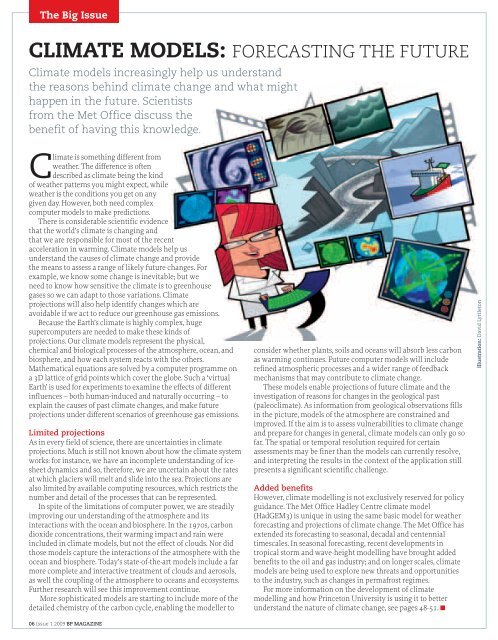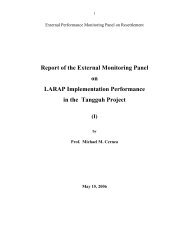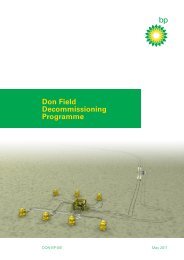You also want an ePaper? Increase the reach of your titles
YUMPU automatically turns print PDFs into web optimized ePapers that Google loves.
The Big Issue<br />
CLIMATE MODELS: FORECASTING THE FUTURE<br />
Climate models increasingly help us understand<br />
<strong>the</strong> reasons behind climate change and what might<br />
happen in <strong>the</strong> future. Scientists<br />
from <strong>the</strong> Met Office discuss <strong>the</strong><br />
benefit <strong>of</strong> having this knowledge.<br />
Climate is something different from<br />
wea<strong>the</strong>r. The difference is <strong>of</strong>ten<br />
described as climate being <strong>the</strong> kind<br />
<strong>of</strong> wea<strong>the</strong>r patterns you might expect, while<br />
wea<strong>the</strong>r is <strong>the</strong> conditions you get on any<br />
given day. However, both need complex<br />
computer models to make predictions.<br />
There is considerable scientific evidence<br />
that <strong>the</strong> world’s climate is changing and<br />
that we are responsible for most <strong>of</strong> <strong>the</strong> recent<br />
acceleration in warming. Climate models help us<br />
understand <strong>the</strong> causes <strong>of</strong> climate change and provide<br />
<strong>the</strong> means to assess a range <strong>of</strong> likely future changes. For<br />
example, we know some change is inevitable; but we<br />
need to know how sensitive <strong>the</strong> climate is to greenhouse<br />
gases so we can adapt to those variations. Climate<br />
projections will also help identify changes which are<br />
avoidable if we act to reduce our greenhouse gas emissions.<br />
Because <strong>the</strong> Earth’s climate is highly complex, huge<br />
supercomputers are needed to make <strong>the</strong>se kinds <strong>of</strong><br />
projections. Our climate models represent <strong>the</strong> physical,<br />
chemical and biological processes <strong>of</strong> <strong>the</strong> atmosphere, ocean, and<br />
biosphere, and how each system reacts with <strong>the</strong> o<strong>the</strong>rs.<br />
Ma<strong>the</strong>matical equations are solved by a computer programme on<br />
a 3D lattice <strong>of</strong> grid points which cover <strong>the</strong> globe. Such a ‘virtual<br />
Earth’ is used for experiments to examine <strong>the</strong> effects <strong>of</strong> different<br />
influences – both human-induced and naturally occurring – to<br />
explain <strong>the</strong> causes <strong>of</strong> past climate changes, and make future<br />
projections under different scenarios <strong>of</strong> greenhouse gas emissions.<br />
Limited projections<br />
As in every field <strong>of</strong> science, <strong>the</strong>re are uncertainties in climate<br />
projections. Much is still not known about how <strong>the</strong> climate system<br />
works: for instance, we have an incomplete understanding <strong>of</strong> icesheet<br />
dynamics and so, <strong>the</strong>refore, we are uncertain about <strong>the</strong> rates<br />
at which glaciers will melt and slide into <strong>the</strong> sea. Projections are<br />
also limited by available computing resources, which restricts <strong>the</strong><br />
number and detail <strong>of</strong> <strong>the</strong> processes that can be represented.<br />
In spite <strong>of</strong> <strong>the</strong> limitations <strong>of</strong> computer power, we are steadily<br />
improving our understanding <strong>of</strong> <strong>the</strong> atmosphere and its<br />
interactions with <strong>the</strong> ocean and biosphere. In <strong>the</strong> 1970s, carbon<br />
dioxide concentrations, <strong>the</strong>ir warming impact and rain were<br />
included in climate models, but not <strong>the</strong> effect <strong>of</strong> clouds. Nor did<br />
those models capture <strong>the</strong> interactions <strong>of</strong> <strong>the</strong> atmosphere with <strong>the</strong><br />
ocean and biosphere. Today’s state-<strong>of</strong>-<strong>the</strong>-art models include a far<br />
more complete and interactive treatment <strong>of</strong> clouds and aerosols,<br />
as well <strong>the</strong> coupling <strong>of</strong> <strong>the</strong> atmosphere to oceans and ecosystems.<br />
Fur<strong>the</strong>r research will see this improvement continue.<br />
More sophisticated models are starting to include more <strong>of</strong> <strong>the</strong><br />
detailed chemistry <strong>of</strong> <strong>the</strong> carbon cycle, enabling <strong>the</strong> modeller to<br />
06 Issue 1 2009 <strong>BP</strong> MAGAZINE<br />
consider whe<strong>the</strong>r plants, soils and oceans will absorb less carbon<br />
as warming continues. Future computer models will include<br />
refined atmospheric processes and a wider range <strong>of</strong> feedback<br />
mechanisms that may contribute to climate change.<br />
These models enable projections <strong>of</strong> future climate and <strong>the</strong><br />
investigation <strong>of</strong> reasons for changes in <strong>the</strong> geological past<br />
(paleoclimate). As information from geological observations fills<br />
in <strong>the</strong> picture, models <strong>of</strong> <strong>the</strong> atmosphere are constrained and<br />
improved. If <strong>the</strong> aim is to assess vulnerabilities to climate change<br />
and prepare for changes in general, climate models can only go so<br />
far. The spatial or temporal resolution required for certain<br />
assessments may be finer than <strong>the</strong> models can currently resolve,<br />
and interpreting <strong>the</strong> results in <strong>the</strong> context <strong>of</strong> <strong>the</strong> application still<br />
presents a significant scientific challenge.<br />
Added benefits<br />
However, climate modelling is not exclusively reserved for policy<br />
guidance. The Met Office Hadley Centre climate model<br />
(HadGEM3) is unique in using <strong>the</strong> same basic model for wea<strong>the</strong>r<br />
forecasting and projections <strong>of</strong> climate change. The Met Office has<br />
extended its forecasting to seasonal, decadal and centennial<br />
timescales. In seasonal forecasting, recent developments in<br />
tropical storm and wave-height modelling have brought added<br />
benefits to <strong>the</strong> oil and gas industry; and on longer scales, climate<br />
models are being used to explore new threats and opportunities<br />
to <strong>the</strong> industry, such as changes in permafrost regimes.<br />
For more information on <strong>the</strong> development <strong>of</strong> climate<br />
modelling and how Princeton University is using it to better<br />
understand <strong>the</strong> nature <strong>of</strong> climate change, see pages 48-51. ■<br />
Illustration: David Lyttleton






![[PDF] Deepwater Horizon: Accident Investigation Report - BP](https://img.yumpu.com/51697031/1/190x245/pdf-deepwater-horizon-accident-investigation-report-bp.jpg?quality=85)










